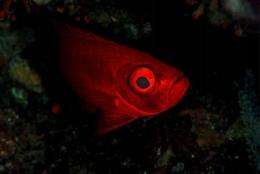Night shift: nocturnal animals take back the day

(Phys.org) -- Scientists document that overharvesting of predators may make it safe for nocturnal prey to emerge during the day.
Many animals that are active only at night appear to have adopted a nocturnal way of life in order to avoid being eaten by predators that hunt during the day. Bats are an excellent example. Modern bats are almost exclusively nocturnal. Researchers believe they may have taken to nocturnal living in to avoid being eaten by diurnal predators such as hawks and falcons.
This raises the question: how do these nocturnal animals respond if the predators that drove them into the dark are removed? This question has great practical importance because people are drastically changing the abundance of predators across the globe by overfishing and overhunting. A study of coral reef fish based in a remote archipelago in the Pacific Ocean suggests that changing predator abundance may blur ecological divisions between night and day.
Scientists from Stanford, University of California at Berkeley, and Harvard compared the abundance of nocturnal prey fish that were active during the day at two atolls: a wildlife refuge teeming with large hungry daytime active predators (e.g. shark, snapper, barracuda); and a nearby populated atoll where these predators have been heavily fished. Their results showed that large‐eyed nocturnal prey fish that normally cower in reef crevices during the day were out and about and much more abundant during the day at sites where the predators had been fished heavily. This research is published in the journal PLoS ONE.
Other studies have shown that rats, lobsters, foxes, and insects, all animals that are mostly active at night, show similar increases in daytime activity in the absence of predators. Usually these changes are considered as one off oddities of nature. Authors of this new study, however, suggest that these observations may reflect a new kind of environmental change: time pollution. In the words of one of the report’s lead authors, Douglas McCauley, “We are aware that we are changing habitats and patterns of biodiversity – but it seems we are also capable of reweaving the very fabric of ecological time.”
More information: dx.plos.org/10.1371/journal.pone.0038871
Journal information: PLoS ONE
Provided by University of California - Berkeley


















